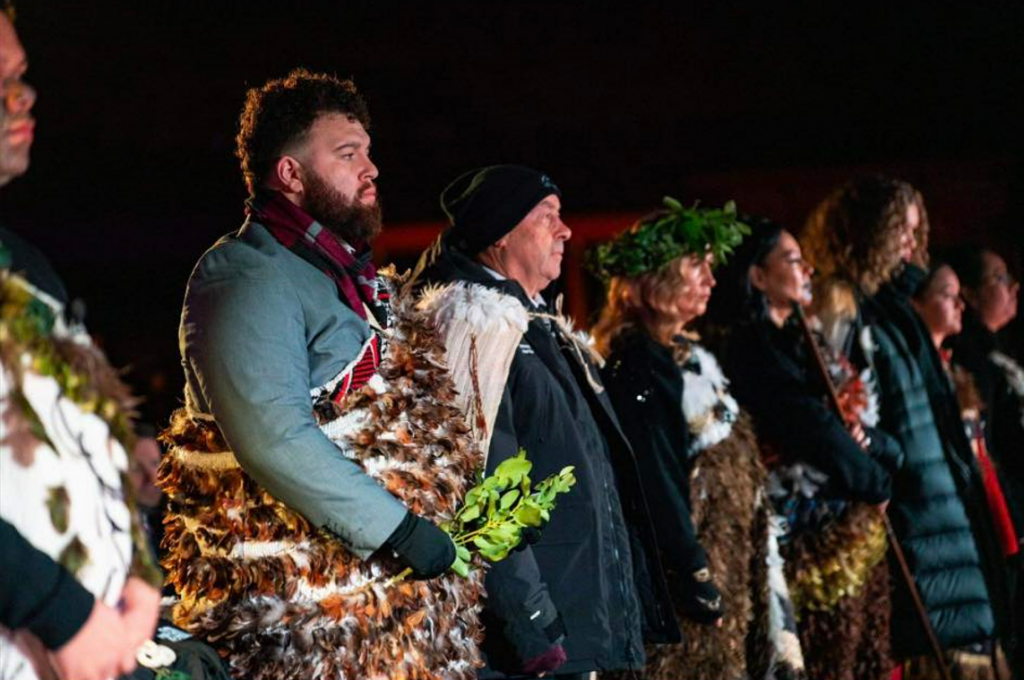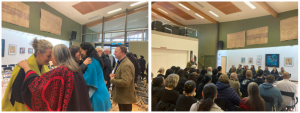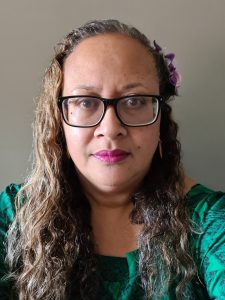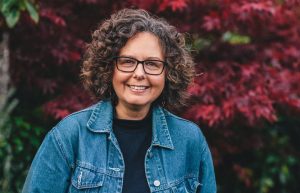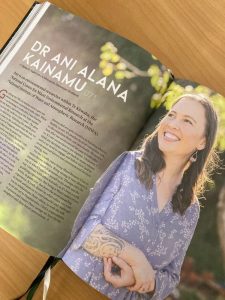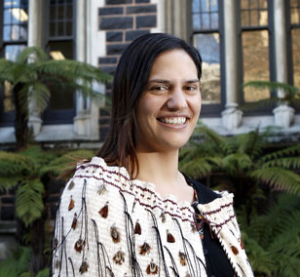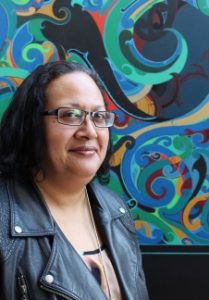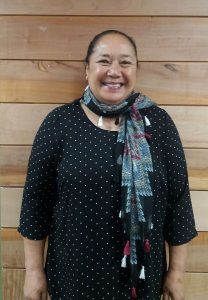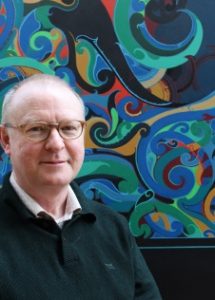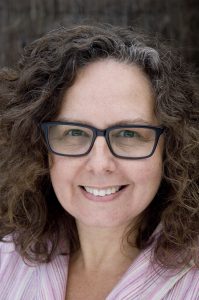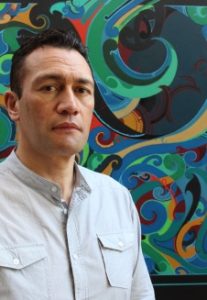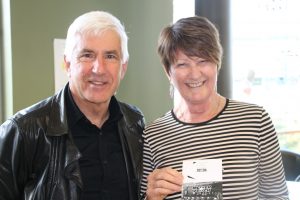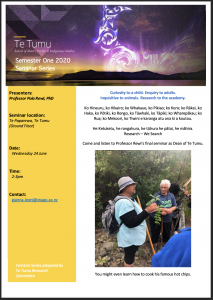Te Tumu scholar part of Kāhui Kairuruku the national Hautapu for Matariki
Ko Kare Tipa tōku ikoa, my ancestry comes from many hapū of Kāi Tahu iwi: (Kāti Ruahikihiki, Kāti Hāteatea,Kāi Te Aotaumarewa, Hinematua, Kāi Tuke, Kāti Huirapa, Kāti Rakiāmoa, Kāi Tuahuriri, Kāti Hinemihi, Kāti Wairaki, Kāti Urihia On Friday 28 June I was honoured to be part of the Kāhui Kairuruku, a collective of language and cultural practitioners that delivered 13 karakia as part of the national Hautapu ceremony held 2,008m above sea level, adjacent to the mighty ranges of Kā Tiritiri O Te Moana, on a pituresque mountain widely known as Treble Cone. Matariki allows us to reflect on whānau and experiences at a time when we welcome the new year. It is also a time to farewell the old, the past year gone.
It was appropriate to hold the hautapu ceremony in Wānaka. Māori history tells of Wānaka where early iwi, in particular ‘Waitaha’, assembled for learning of tribal lore. Wānaka is Kāi tahu alternative form of the word ‘wānanga’ referring to the ancient schools of learning. The area boasts of rocky alpines, tussock foliage and lakes dug out from the eponymous ancestor Rākaihautū. From the ski field on Treble Cone, one is able to feast eyes on the visible features of the land, the aesthetic appeal formed by the digging stick of Rākaihautū. Lakes dug out in Te Waipounamu are known as Kā Puna Karikari a Rākaihatū (the springs of water dug by Rākaihautū).
From ancestoral acts of the past to what is experienced today, Kāti Ruahikihiki descandants (the kairuruku for the hautapu) are made up primarily of young language assailants raised in the Kāi Tahu language revitalisation strategy: Kotahi Mano Kāika (KMK). KMK leads the charge to reinvigorate our language within Kāi Tahu homes and communities. It is a 25 year old strategy which aims to have at least 1000 Kāi Tahu kāika speaking te reo Māori by 2025.
As a practitioner, I have been both a beneficiary of and contributor to KMK. My children and grandson are part of the collective to revitalise and change the narrative with language normalisation here in Te Waipounamu. To be apart of the collective with our young adults is a tremendous highlight for me as a hākui in the strategy. The Hautapu ceremony is shared with a different iwi annually, this recent ceremony is historical for Kāi Tahu, it highlights the language strategy in action alive and vibrant, it sets a precedence of first language speakers who can conduct formal tikaka in te reo. I may not be here to stand with this collective when the Hautapu returns to Kāi Tahu iwi in the future, but I’m proud to have had this moment of standing with first language speakers adding to the histories of today.
Te Poroāki o Lachy Paterson & te Pōhiri o Roma Donaldson-Gush
Last week Te Tumu celebrated well with the retirement of Emeritus Professor Lachy Paterson and the arrival of new Māori Studies pūkenga, Roma Donaldson-Gush. Roma, of Ngāti Porou, Taranaki, Ngāti Tūwharetoa, Kotirana descent, joins Te Tumu staff with a background in bilingualism and intergenerational language and culture transmission for Māori. Roma will be completing her PhD studies as well as teaching into the Māori Studies programme. She is a Te Tumu alumnus having previously completed postgraduate study looking at Te Reo Māori in urban New Zealand. The pōhiri, held on Wednesday 28 June, included representatives from Office of Māori Development, Te Huka Mātauraka, Te Rōpū Māori, staff from Te Tumu and the wider university. Roma was supported by her whānau, colleagues, and friends in a day filled with the celebration of new relationships and excitement for the future of Te Tumu.

L: Dean of Te Tumu Patrick Vakaoti garlanding Lachy with a salusalu. R: Angela Wanhalla, Lachy Paterson and whānau
Ara mai he tētēkura, wehe atu he tētēkura. With a new frond beginning, a mature frond leaves.
With over 16 years of service as a teacher, mentor, friend, and conspirator, Lachy Paterson was farewelled in an intimate gathering of colleagues and whānau on Friday 30 June. Many spoke of the contributions Lachy has made to Māori Studies, Te Tumu and the university as a whole with several teaching, administration and leadership roles. Stories unfolded about his days as a student, teaching fellow and ultimately his unrelenting commitment to Te Tumu. Although it was a bittersweet day, Te Tumu looks forward to a continuing relationship with Lachy as an emeritus professor and eagerly await his future publications and foray into YouTube.
Te Tumu welcomes new lecturer

The manuhiri await the karanga. Dr Jess Pasisi stands in the centre of the front row, and Maioha Watson on the far right.
Fakaalofa ahi atu!
On Wednesday 7 September, Te Tumu welcomed our newest staff member, Dr Jess Pasisi, who is of Niuean descent, as well as Pākehā, Ngāti Pikiao and Tahitian roots.
This was also an opportunity to welcome and acknowledge Maioha Watson (Ngāti Maniapoto) who has been doing an excellent job teaching MAOR308 this semester.
The pōwhiri followed tikanga Māori, but also incorporated Pacific elements as well, with Niuean speeches and a performance by our Pacific coordinator Telesia Kalavite alongside Tongan students, as well as Pacific food for the hākari. Special thanks must also go to Maioha, the kaikōrero for the manuhiri, Neihana Matiu who spoke for the tangata whenua, and Kare Tipa who had held waiata classes for staff, and who kept us to tikanga.
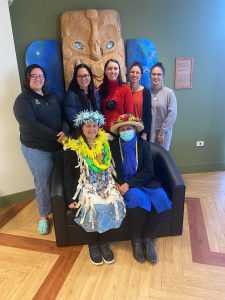
Rear, from left: Waikato staff and postgrads: Marcelle Wharerau, Marama Salsano, Karamea Moana Wright, Hineitimoana Greensill, and Jesi Lujan Bennett. Front: Jess Pasisi and Luisa Posimani.
Jess is currently finishing off a Health Research Council funded postdoctoral studies on Niuean wellbeing and happiness that she started while at the University of Waikato. She also has research interests in climate change in the Pacific, and the Pacific countries that make up the New Zealand realm (Cook Islands, Niue and Tokelau).
Some Waikato postgraduate students and staff came with Jess to hand her over to Te Tumu. Dunedin-based people may well remember Marcelle Wharerau, who worked and studied in Te Tumu, gaining an MA in Indigenous Development. After the pōwhiri, these guests attended a ‘conversation’ organised by Dr Emma Powell, together with a number of Te Tumu staff. Everyone had some time to share their research and discuss some of their experiences within academia.
Te Tumu is very pleased to have Jess joining our Pacific Islands Studies team, and look forward to what she can bring us. Fakaaue lahi!
New opportunity for Dr Michelle Schaaf
Being an academic at a university is not just about teaching and research. It’s also about leadership and capacity building. This post looks at new opportunity for Dr Michelle Schaaf of our Pacific Islands Studies programme to develop these skills.
Te Manahua New Zealand Universities Women in Leadership Programme (NZUWiL) is an initiative for the New Zealand tertiary education sector funded by Universities New Zealand – Te Pōkai Tara. This programme aims to recognise and enhance women’s leadership capacities and influence within universities. It provides opportunities for participants to examine leadership approaches and strategies; increase understanding of the tertiary education sector, research management, leadership capability, diverse learning environments that builds on the diversity of experience within the group, personal and national networks, active communication and change management techniques.
Michelle is the current Humanities Associate Dean Pacific and a senior lecturer in Te Tumu. At the end of March, she received confirmation that she was the recipient of the Te Manahua NZUWiL Pasifika Women Scholarship and a successful University of Otago nominee selected to attend the 2022 Te Manahua New Zealand University Women in Leadership: Academic Programme.
While Michelle has held numerous leadership roles, she strongly believes that there is always the space and need to upskill to ensure that one does not become a complacent leader. She grasped the opportunity to apply for Te Manahua NZUWiL Programme and the Pasifika Women Scholarship, as vehicle through which she could learn how to become a more effective leader who responds to challenges in a timely and respectful manner. On completion of this programme, Michelle proposes to reciprocate the University of Otago’s nomination, through the transfer of this new basket of knowledge and skills to capacity build and mentor staff.
Erica’s research is in the news again!
It’s always great when Te Tumu research gets disseminated to more public audiences. In the last few days, Erica Newman‘s research on the children of Māori who were adopted into non-Māori families has made it into the Otago Daily Times, and Kim Hill’s Saturday Morning programme on Radio New Zealand.
Click here for the ODT article, and on the bar below to listen to the RNZ mp3 file.
Te Tumu featuring in a new book on Indigenous Women
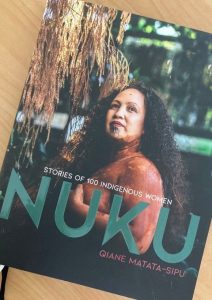 A new book, Nuku: Stories of 100 Indigenous Women, written by Qiane Matata-Sipu has just been publishing containing (as the title suggests) stories from 100 indigeneous wāhine, mainly wāhine Māori.
A new book, Nuku: Stories of 100 Indigenous Women, written by Qiane Matata-Sipu has just been publishing containing (as the title suggests) stories from 100 indigeneous wāhine, mainly wāhine Māori.
“These women and their stories dare to carve their own unique portrait, showing that the world can be positively shaped by our diverse and connected Indigenous voices. Stories about who we are, not who we’ve been told to be.” Qiane Matata-Sipu
Within this book Te Tumu has an alumna, Dr Ani Alana Kainamu, and current Lecturer, Dr Erica Newman. As with all narratives within this pukapuka, both Drs Kainamu and Newman talk about their own journeys within te ao Māori and what they are currently doing.
This book is well presented with fabulous stories from some amazing women.
If you are the type who prefers to listen rather than read, longer versions of each women’s kōrero are available as podcasts on https://nukuwomen.co.nz/nuku100/
2020 Te Tumu Research Round-up
Well, it’s been a weird year for everyone, and the coronavirus certainly made our work harder, with a lot of our energy going into making sure we were able to still offer quality teaching to our students. We have also had a number of staff move on to greener pastures: Jim Williams and Lyn Carter retired; Gianna Leoni left us to take up a research role with Te Hiku (where former colleague Suzanne Duncan also works); Megan Pōtiki has shifted to the Office of Māori Development in the university; and Poia Rewi has taken up the Tumu Whakarae (CEO) position at Te Mātāwai. So we are expecting to see a bunch of fresh faces in the new year.
Research has still carried on. As the Chair of our Research Committee, Michelle Schaaf says, “Despite Covid, the retirement and departure of staff; the research committee’s commitment to building a successful research culture continues and owes its success to the oversight and guidance provided by senior staff directly. The committee continues to monitor staff research activity and promotes staff research through various mediums: research website long running and informative Research Blog.”
We also asked staff to tell us about their research, and what they’ve been up to. Here are their replies.
Karyn Paringatai’s Marsden
Karyn is lead investigator on the Marsden project: E kore au e ngaro! The enduring legacy of whakapapa (awarded $823,000), which looks at the importance of whakapapa in health, in particular to whānau that carry the cancer-causing hereditary mutation in the CDH1 gene.
2020 started with good intentions to advance my Marsden research with a lot of face-to-face engagement sessions planned, but those plans fizzled quickly during the March-April lockdown. But things have picked up during the second half of the year with a lot of gusto. In September I met with Maybelle McLeod, Pauline Harawira and Erin Gardiner from Kimihauora Health and Research Centre in Tauranga to co-develop a research topic for future PhD student, Kahurangi Salu. Pauline and Maybelle were two of the four lead investigators of the research project that discovered the CDH1 gene mutation. A conversation with Pauline went as follows:
Pauline: “My mother was from Hicks Bay.”
Me: “Oh wow.”
Pauline: “Yeah her younger brother, we called him Uncle Boy, his first name was Manuhou. His middle name was Paringatai. He was named after that koroua that died in the war.”
FUN FACT: My whānau are based just over the hill from Hick’s Bay. My daughter is called Manuhou Paringatai. She was named after that same koroua who died in the war, my grandfather’s first cousin. Whakawhanaungatanga – well and truly achieved.
Check out this short video featuring Karyn and the wider project.
This meeting coincided with a wider whānau hui. It was an opportunity to speak to whānau, canvas opinions, make connections, and recruit participants. The concerns they expressed were echoed in my research objectives. As a result I have been involved in developing a post-surgery nutrition research project and a funding proposal for a Kaihautū – someone who will help develop a pre- and post-surgery management care plan that takes in to account Māori realities. Watch this space……
Michelle Schaaf’s research
The Covid pandemic really pushed me to think of what the different ways are, that I could have students demonstrate what they know. There’s been a lot of me letting go of control, to try and build resilient and more-independent students. Teaching remotely also made me look at my own course content with fresh eyes. In terms of my research, I was forced to be adaptable, and implement strategies to mitigate the long-term impact of research disruptions.
new Publications
UORG: “Childhood in a changing Pacific”
Freeman, R.M. Schaff, C. Ergler, M. Kivalu, A. Niusulu, T. Tua’a and H. Tanielu, Childhood in Changing Pacific’ Summary Research Report August 2020, (Summary Research Report), Dunedin: School of Geography, University of Otago.
Childhood in Changing Pacific’ Summary Research Report Presentation and Exhibition. 10 November 2020. This was a report presentation to participants and their families, in Dunedin and Samoa, on campus and via zoom platform. See here for more.
Articles submitted
“Kinship and belonging: Pacific children’s perspectives on the diaspora” to the Childhood Journal.
“Connections to community and culture, a photographic analysis of place attachment amongst Pacific Island children” submitted to Children’s Geographies.
Telesia Kalavite’s latest article
Telesia has recently published an article, “Toungāue cooperative pedagogy for Tongan tertiary students’ success” in the Waikato Journal of Education, 25, 1 (2020). You can read it here.Toungāue cooperative pedagogy
Abstract
Cooperative Pedagogy specific to Tongans can enhance students’ academic success in New Zealand’s tertiary education. Tongan students’ success depends on teachers’ recognition and understanding of Tongan students’ sociocultural context which involves their pule‘anga (bureaucracy), famili/kāinga (family), siasi (church) and fonua (country) relationships. Tongan students should not be treated within the Pacific groupings because ‘Pacific’ is a term of convenience for peoples who originate from different countries in the Pacific region whose cultures are uniquely different from one another. The term ‘Pacific’ tends to make these students live in the shadow of being treated as if they have the same needs in the classroom. The culturally specific needs of Pacific students are obscured by the assumption that they are homogenous. Academics and educational authorities in New Zealand need to recognise the importance of Pacific students’ culturally specific needs in their educational environments to move towards solving the problems of underachievement. This article explores the use of a culturally specific Tongan Toungāue Cooperative Pedagogy for teaching Tongan students in New Zealand tertiary education. Toungāue Cooperative Pedagogy is rooted in Tongan students’ sociocultural context which is at the heart of the Tongan society. More importantly, this proposed Toungāue Cooperative Pedagogy is transferable and could also be beneficial to other Pacific and Indigenous cultures.
Keywords
Toungāue cooperative pedagogy; Tonga tertiary students’ success; Pacific diversity; Pacific ethnic special needs.
Tangiwai Rewi’s projects.
Most of the research related mahi I have been consumed by since 1 July has involved the 0.2 FTE Ngā Pae o Te Māramatanga co-management of the Te Pāpanga Te Reo Māori, Ngā Tikanga Māori (TRMNTM) mahi along with Dr Gianna Leoni with the departure of Professor Poia Rewi. The list includes:
- Running a Te Kōrerorero a Ngā Tumu Whakarae webinar hosted on the last day of Māori Language week 18 September 2020 to encourage eight CEO’s to share their ideas about working together for te reo Māori research under Te Papa Kōrero. The purpose of Te Papa Kōrero is to provide coordination and leadership for the implementation of both Maihi (Maihi Māori and Maihi Karauna) in respect of the Māori language strategy. We managed a 50% success rate by confirming Shane Taurima (Māori Television), Larry Parr (Te Māngai Pāho), Dr Poia Rewi (Te Mātāwai) and Ngahiwi Apanui (Te Taurawhiri) to participate in the session facilitated by Dr Gianna Leoni and myself (from Te Tumu at the University of Otago), in our roles as the NPM Co-Managers of Te Reo & Ngā Tikanga Māori Platform. We aim to invite the other four Chief Executives of Te Puni Kōkiri; the Ministry of Education; the Ministry for Culture and Heritage and the Department of Internal Affairs, who were unavailable on this occasion, to join another webinar at a later date.
- N03 Project Te Reo me ngā Tikanga Māori – Named Scholarship – Professor Wharehuia Milroy; Understanding, articulating and measuring the language shift at the micro-level As part of the Ngā Pae o te Maramatanga Summer Internship Projects 2020-21 we were asked to develop, organise and then manage and supervise this named scholarship to recognise the scholarship and leadership of the late Te Wharehuia Milroy to the revitalisation and normalisation te reo me ngā tikanga Māori. In doing so, the intern will review and develop an understanding of Milroy’s research and scholarship, that is specific to te reo Māori normalisation and excellence. Dr Gianna Leoni will be the NPM Investigator who will work alongside Ria Tomoana (Kaiwhakahaere Rangahau – Te Mātāwai) to supervise the student.
- The third project we have been doing is our Collectivising Ngā Pae o Te Māramatanga Publications which we presented on at the 9th Biennial International Indigenous Ngā Pae o te Maramatanga (NPOTM) conference online 18-20 November. In three phases, the first produced punchy, attention grabbing abstracts summarising the articles.The second attributes keywords to the articles along with word clouds. To ensure accessibility after these two phases, the third phase thematicises the lists so that any person wanting to know what articles are published in each issue can search via content themes. Phase 1 comes to an end this year while phases 2 and 3 will look at completion by end of April 2021.
On a personal research note:
- I continue to push through with my Tuupuna Times research project holding wānanga for whānau and hapū on request, on how to collect stories from their tuupuna.
- My research plan for RSL is a little off beam given the attention to the Ngā Pae o Te Māramatanga workload. However, the next two months will be busy getting that back on track, assisted gratefully by the Te Koronga continued funding support of $5000 development grant this year and recent success with my UORG application He Whakapakari Ake i Te Tuakiri Maaori of $11, 434 which takes effect 1 January 2021.
- I contributed a Māori perspective to a paper, Ko tā te Māori aronga ki te whakamātao kikiri. A Māori perspective on embryo cryopreservation, which is currently being reviewed by the lead author.
- I still have two articles to complete by the start of next year!
That’s it!
What is Michael Reilly doing?
Since 2019 I have off and on been working on a Māori tribal history manuscript. It currently is organised around the chief themes of tribal traditions: creation, culture heroes, the waka migrations, and the stories about the many generations of descendants who settled and populated this new country. The latter extends over a wide range of topics such as rangatiratanga or leadership; mana wāhine, mana tāne or gender relationships; and possibly, the place of emotion words such as whakamā, or shame, and pōuri, or grief. Each chapter is organised around a selection of traditions on the topic from different iwi. Attention is paid to southern traditions where possible. These traditions are normally taken from published sources, often collections of traditions with a limited analysis or explanation of the content of the narratives.
My aim is to provide the cultural context of these stories in order to help the modern reader understand the layers of meaning found within each text. This often involves an immersion in older ethnographic works by the likes of Elsdon Best, Te Rangihīroa and Raymond Firth who put on record information shared with them by generations of Māori scholars. By locating the texts within this ethnographic record, I can better peel back the layers of meaning found in each of the stories. To me, it opens a window upon that ancient world of the ancestors, Te Ao Kōhatu, the Stone World, as Bruce Biggs once described it. This approach resembles the kind of work I have been pursuing for some years, both in Aotearoa and in the wider world of Ancient East Polynesia, notably Mangaia.
Behind this approach lies an influential model: Erich Auerbach’s Mimesis: The Representation of Reality in Western Literature. He began writing it while in exile as a German Jew teaching in Turkey during the Second World War. Each of his chapters selects a passage from an author, from Homer through to Virginia Woolf. He uses each of them to explore ideas about how Western literature has sought to represent the world. His aims differ from mine but some of his methods have encouraged me to try and explore the totality of Māori traditions from its beginnings in time down perhaps as far as the edgy beginnings of modern Aotearoa, ending however, in the early nineteenth century when Māori understandings of their world remained dominant. For it is their story after all I am interested in.
More recently, I have initiated other smaller projects after approaches to provide publications either for edited books or journals. One looks at emotions in Oceania, drawing on selected texts from particular Island societies, including Mangaia and Aotearoa, that illustrate important concepts such as love, shame and grief. I am also interested in comparing the different words used to describe the human organ or centre of emotions, such as ngākau and manawa.
Currently, with the help of a research assistant, Jade Higgan McCaughan, I am examining evidence found in the songs published in the four volumes of Ngā Mōteatea, edited by Apirana Ngata and other scholars. Another project was prompted by plans to celebrate the coming of the London Missionary Society to the Cook Islands. I decided to look at some letters by a 19th century Mangaian church minister, Mamae. In one he describes his experience of a hurricane, while in others he gently criticises the editing of local texts by his colleague, William Wyatt Gill; an interesting case of the native speaking back. We see Mamae as a skilled writer who is actively participating not only in the recording of traditions, but also in how it is presented in published form. These kinds of letters give a window into the work and contributions of an important early scholar and missionary whose name, however, is far less well known that Gill’s, for it is the latter’s name that appears on the title pages of the ethnographic studies these two men collaborated in producing.
All this work takes place in the small intervals of relative calm permitted to me when I am not busy either teaching or discharging the responsibilities of Acting Dean of Te Tumu, a role bequeathed to me by Poia Rewi on his departure for Te Mātāwai in Te Whanganui-a-Tara.
Erica Newman’s exciting new project
Erica is lead investigator in a new fast-start Marsden project beginning in 2021: Journey Home: Descendants of Maori adoptees search for their turangawaewae. Only researchers who have recently completed their PhDs are eligible to apply for a Fast Start Marsden grants.
This research will investigate the ripple effects of the 1955 Adoption Act from which some Māori adoptees grow up not knowing their whakapapa, and look at the journeys that some of their descendants undertake in the search for their tūrangawaewae. Erica’s project has already attracted quite a bit of media attention, on te aka kumara, and waatea news, which is useful for getting the project out there to the descendants who may want to make contact with Erica. There is also a closed Facebook page just started, “Descendants of Māori Adoptees”, a safe space for these descendants to ask questions, share stories and support each other.
Erica was also asked to come on the team of the Marsden-funded project, Te Hau Kāinga: Histories and Legacies of the Māori Home Front, 1939-45, to contribute research on tikanga, whānau and adoption
Erica teaches in some large classes, and says that she found challenging converting on-campus papers to on-line. “This year has been quite draining with covid, and the future is a little unsettling when thinking about teaching, not knowing whether we will (or won’t) go into more lockdowns next semester.” But she is keenly looking forward to getting into her research.
Dr Paerau Warbrick’s goings on
In terms of research this year, I have been beavering away at articles.
Recently I have had an article accepted by the Australia & New Zealand Law & History journal, which will be published later in 2021. It is on Māori and Citizenship. And it takes a look at what this phrase ‘citizenship’ meant for Māori up until the 1950s.
My research is taking on a distinctly historical political flavour, on the heels of my 2019 article in the New Zealand Journal of History about Māori elections in the nineteenth century.
I have finished a chapter for a book edited by Lachy Paterson, myself and Megan Pōtiki on Māori texts, contexts, and their resonances for today. This chapter looked at Hēnare Tomoana, MP for Eastern Māori 1879-1884, and his pivotal role in the fall of George Grey’s Government in 1879.
Recently I submitted an article to the Journal of New Zealand Studies. It looks at the two Māori Election Petitions that try to unseat the MPs Karaitiana Takamoana (Eastern Māori) in 1876 and Hone Mohi Tāwhai (Northern Māori) in 1879. In order to understand these petitions, you really have to come to grips with the complex wider political machinations of the Fox, Vogel and Donald McLean political blocs, and the George Grey and John Hall group of MPs in Parliament.
Currently, I am working on an article for the Journal of Polynesian Society on the monumental election battles between Wi Pere and James Carroll over the Eastern Māori seat between 1884-1890. It is an attempt at historical psephology where I use fragmented polling booth data to uncover complexities in the Māori communities in the Eastern Māori election. I am looking at submitting this to the journal by mid-December 2020 or more realistically late January 2021.
This past year has definitely been a challenge for everyone. I wish everyone a safe and reflective Christmas and New Years. Mauri ora koutou.
Lachy Paterson’s doings
Lachy is lead investigator, with Angela Wanhalla (History) on the Marsden-funded project: Te Hau Kāinga: Histories and Legacies of the Māori Home Front, 1939-45, looking at what life was like for Māori in New Zealand during the Second World War, and how these experiences shaped Māori society in the years following the war. He is currently on RSL.
This project incorporates a large team. Alongside Angela Wanhalla and I, we have Erica Newman (as discussed above) as research associate, and five research assistants (one of whom is based in Wellington, and another in Auckland). We’ve also two excellent student researchers, Hannah Barlow and Stacey Fraser, both history post-graduates with research aligning with our project. It’s also been wonderful to be able to fund Māori summer scholarship students, with three who undertook projects last summer. Due to the travel restrictions, we have been unable to go to several overseas conferences, so redirected some of those funds into more summer scholarships. This summer we have six young Māori students (two partially funded through the Humanities Māori Summer Bursaries) who have just started their projects.
A key tool for our project is the Te Hau Kāinga website, which is fully bilingual. The site features a Stories page where we are posting research as we go along. It’s a bit eclectic, but definitely worth a read. The stories are also circulated to Facebook pages: our own FB page @maorihiomefront, the NZ History Teachers page, and the Māori-language versions onto the Te Mana o te Reo Maori page.
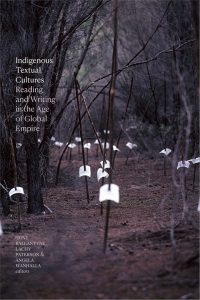 I have been fortunate to see a couple of publications appear this year. Indigenous Textual Cultures: Reading and Writing in the Age of Global Empire was recently published with Duke University Press, 2020. This project came out of a 2014 symposium in Dunedin featuring a number of eminent international scholars, and Tony Ballanyne, Angela Wanhalla and I co-edited the collection of essays that came out of the symposium.
I have been fortunate to see a couple of publications appear this year. Indigenous Textual Cultures: Reading and Writing in the Age of Global Empire was recently published with Duke University Press, 2020. This project came out of a 2014 symposium in Dunedin featuring a number of eminent international scholars, and Tony Ballanyne, Angela Wanhalla and I co-edited the collection of essays that came out of the symposium.
Sometimes things take time. I attended a symposium on colonial newspapers at Yale University in 2017, looking at the notion of Habermas’s “public sphere” within colonial societies, presenting on Wellington Māori letters in Te Karere o Poneke in the 1850s. This was recently published as “Te Karere o Poneke: Creating an Indigenous Discursive Space?” in “Special Issue: Colonial Public Spheres and the Worlds of Print”, Itinerario: Journal of Imperial and Global Interactions,44, 2 (2020) edited by Emma Hunter and Leslie James.
My argument is that if you used the conditions of the Habermasian model of a public sphere (a rather Eurocentric theory) it was difficult to apply to Māori of the Wellington period in the 1850s. They were not urban, bourgeois, or anti-clerical, nor in control of the media. But the impact of colonialism nevertheless gave them new ways of looking at the world, and that this newspaper gave plenty of scope for them to articulate them.
I have also submitted a chapter, “Race and Revolution: Haiti and the Kīngitanga, 1863” for a new book, edited by Lyndall Ryan and Angela Wanhalla, on Aftermaths: Remembering Colonial Violence in New Zealand, Australia and the Pacific. This should appear with Otago University Press in 2021. I was also asked to contribute a case study for the planned Edinburgh Companion to British Colonial Periodicals, and have written (but not yet submitted) a piece entitled, “Making Māori citizens in Colonial New Zealand: the Role of Government Niupepa.” I anticipate this coming out in 2022 with Edinburgh University Press.
Another project is to write a book on Māori print culture, from the first book in 1815 through to the present. I have pretty much written a draft, but this needs some extra work and refinement. And as Paerau mentioned above, he, Megan Pōtiki and I have a planned edited collection on Māori-language texts that we plan to get on to when we have a spare breath.
Te Tumu’s “new” lecturer
Te Tumu is excited to announce the appointment of a “new” lecturer. Of course, many will already know Dr Erica Newman, as she has studied and worked in Te Tumu in various roles over many years. Moving into a confirmation-path lecturer’s role in the Indigenous Development programme is the culmination of all her hard work.
Erica’s research has focused on children and adoption. She undertook her BA (Hons) in Te Tumu, completing a dissertation on Māori, European and “half-caste” children in New Zealand from 1840-1852, with a specific focus on the care of children. She followed this with her MA, a history of adoption/whāngai within Aotearoa New Zealand, including the concept of “whāngai”. This research contains a special emphasis on transracially adopted Māori children and its effects on future generations, something pertinent to Erica’s own whakapapa. Her PhD, completed in 2018, looked at the adoption of children in Fiji during British colonial rule of 1874- 1970, including both indigenous and colonial practices and institutions. Erica has also attended various conferences, and published on her research, including an article on transracial adoption in the prestigious American Indian Quarterly in 2013.
More recently Erica has managed to get through to the second stage of a Fast Start Marsden application on the historical effect of adoptions for descendants of Māori adoptees, how adoption not only affects the adoptee, adoptive parents and biological parents but the ripple effect carried down to following generations. This includes the importance of whakapapa in how Māori adoptees are able to, or not able to, identify themselves as Māori. We have our fingers crossed that Erica’s Marsden bid is successful, as this will be exciting and useful research.
Erica has managed a strong research trajectory despite a heavy teaching load. She has long been responsible for Te Tumu’s giant MAOR102 Māori Society paper, managing hundreds of students each year and a troupe of tutors. Last year she was part of team organising Te Tumu’s modules in the (even larger) POPH192 Population Health paper. But since 2008 Erica has also taught in a variety of other papers in all of Te Tumu’s programmes over the years, as well have undertaken supervision duties in the Master of Indigenous Studies programme. We’ve seen a number of innovations, such as an in-house journal for the MAOR202 Tikanga and Māori paper, to give undergraduate students an idea of what it is like to publish an article, and developing special tutorials for MAOR102 students who come to university already very knowledgeable on tikanga Māori.
So in many ways, not too much is going to change for Erica—she will still be working flat-tack on her research and teaching. It’s just wonderful that we can all celebrate in her success.
He poroporoaki ki a Dr Lyn Carter
Te Tumu is seeing further staff changes with the retirement of another senior staff member, Dr Lyn Carter who, most recently, has been the Programme Coordinator of our Indigenous Development programme. Lyn was farewelled today at Te Tumu, accompanied by friends and colleagues from Te Tumu and the wider university, and by members of Kāti Huirapa ki Puketeraki.
Lyn was born in Christchurch but lived a large part of her life in the North Island, first in Hastings then in Auckland. Her dad’s parents emigrated from England after the First World War, and on her mother’s side she has links to early Scottish settlers – her great-grandparents had a boat building business at the bottom of Wharf Street in Dunedin. Her Kāi Tahu connections (Kāti Huirapa, Kāti Hawea, Kāti Ruahikihiki, with connections to Te Whānau a Apanui through the Stirling whānau) also come through her mother and grandmother through the Wybrow whānau.
After taking a few extra-mural papers at Massey as a young mum, Lyn enrolled a few years later at the University of Auckland as a mature student (known as “adult learners” at the time), and completed a BA, MA and PhD, all in both Social Anthropology and Māori Studies. She had some stellar names as supervisors for her postgrad study, such as Patu Hōhepa and Ngāpare Hopa, Sir Hugh Kāwharu and Andrew Sharpe. Lyn’s MA investigated “how oral traditions verify place on the landscape – this meant looking at the whakapapa relationships that make us who we are”. Her PhD, completed in 2003, was “Whakapapa and the State: Some Case Studies in the Impact of Central Government on Traditionally Organised Māori Groups”. Lyn says that she “steered slightly away from [her MA topic] with my PhD research mainly because of the circumstances surround Kai Tahu at the time. The treaty settlement negotiations and the eventual settlement made me think quite a lot about how being registered with an iwi could skew whakapapa from being the underlying force of identity and connections, relationships and so on, to becoming a name on a registration list. So I looked at how treaty settlement structures impacted on tradition-based whakapapa.” The thesis caused some debate within Ngāi Tahu circles.
Lyn undertook a variety of roles at the University of Auckland. She tutored for Jane McRae’s oral traditions papers, and through Jane and Jenny Curnow she became part of a team, in a Marsden-funded project, to develop English-language abstracts for articles in the Niupepa Māori corpus. These abstracts allow researchers who do not read Māori a window into the many Maori language newspapers from the nineteenth and early twentieth century. Lyn was also offered the lectureship teaching Ranginui Walker’s old paper, Maori Society, and developing further papers in contemporary Maori Society and Governance. During this time Lyn also fitted in a year teaching in the history programme at the University of Canterbury.
Lyn went on to become the Director of the School of Māori Development and Humanities, Waiariki Institute of Technology in Rotorua. Later, she moved to Te Whare Wānanga o Awanuiārangi in Whakatāne as Interim Director to develop and implement the Centre for Post Treaty Settlement Futures, working alongside Professor Tā Hirini Moko Mead and Tā Wira Gardiner. This work developed from her PhD research around settlement structures and governance challenges. While at Awanuiārangi, Lyn also held a position as Professor of Anthropology in the Post Graduate School, which involved both teaching and research.
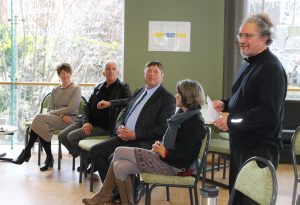
Poia Rewi (R) farewelling Lyn on behalf of Te Tumu. From left, Lyn and John, Matapura Ellison, and Katharina Ruckstuhl.
In 2011 Lyn joined us in Te Tumu. She says “I have worked with some really good and dedicated people here”. She is an active staff member, whose teaching and leadership has mainly been within our Indigenous Development programme. She has also formed excellent links with colleagues from other academic units, such as Geography and the Centre for Sustainability.
Coming to Otago allowed Lyn to engage more fully with her local Kāi Tahu connections. While she was in Auckland she helped found (with Hirini Matunga and Kepa Morgan) the taura here group, Kai Tahu ki Tamaki Makaurau. She already owned a crib at Warrington, so also used to attend various things at Puketeraki Marae at Karitāne so when she eventually moved down here to the University of Otago she was already involved to some extent with the marae – that spread to being on various committees and becoming very much part of the day-to-day life. She says “When I had my stroke I lived in our kaumatua house next door to the Runaka offices and that was amazing – such great support and whanaukataka from just living that close. I used to say that living away one could still participate, and yes you can, but I now realise that it is not the same as being in the landscape and rejoining with the whenua.”

Megan Pōtiki, Hinerangi Ferrall-Heath, Janine Kapa, Khyla Russell, Lyn Carter, and Katharina Ruckstuhl.
Lyn was able to capitalise on her connections to Puketeraki in her popular paper, INDV301: Māori and Indigenous Development, Ethics and Governance, which not only provided students with theoretical tools, but took them outside the classroom for practical work with iwi and community groups on local projects.
Lyn’s research has followed a circular path with her current research interests drawing on her earlier research on how oral traditions verify place on the landscape. “I have now gone full circle and concentrate on place naming and landscape and identity – this led to me working with Sami researchers in arctic Norway where awareness of landscape and place naming shapes their existence. My research focus for the past 14 years has been on landscape and identity and in particular how place names can act as environmental indicators for landscape changes over time – more recently in the context of climate change. Again this is a key area working with Associate Professor Kaisa Helander in Gouvdageaidnu, the Sami capital in northern Norway.”
Lyn has many highlights from her academic career to look back on. “There are so many really – teaching has always been rewarding and seeing post-grad and graduate students develop and flourish has been great – brings truth to the whakatauki about new nets taking over from the old in terms of legacy for future Maori academics at universities. Each generation is the legacy of another. I have always felt privileged to have worked with people like Patu Hohepa, Bruce Biggs, Margaret Mutu, Ranginui Walker, Wairete Norman, Hugh Kawharu, up at Auckland – The ones who were instrumental in developing Maori Studies at a University and also getting the marae in place there.
“Te Wananga o Waipapa Marae never seemed like a University Department – more of a meeting of Maori minds. I remember we all took part in the Foreshore and Seabed march across the Harbour Bridge and hosted and supported the various hui and protest groups at Waipapa Marae – in some ways the Department operated as a marae, and the various protests were Maori society in action – Never sure though if many of the students appreciated it all LOL. But those were different times.
“What I have particularly liked at Otago is the whakawhanaukataka between Maori academics and staff on campus and how that brings Maori together from all disciplines – Maori first and that underpins academia.
“Perhaps the main highlights then are all the people I have met and worked with in some capacity and the broadening of mind and thought that that brings with it; not to mention the conferences and research projects that have stretched my own knowledge and capabilities for the better – I have discovered that yes, we are always learning.”
In 2018, Lyn published Indigenous Pacific Approaches to Climate Change: Aotearoa/New Zealand, published as part of Palgrave’s Studies in Disaster Anthropology Series. Click here to access the e-book. This was a sister volume to former Te Tumu academic, Jenny Bryant-Tokalau’s Indigenous Pacific Approaches to Climate Change: Pacific Island Countries.
Lyn says, “Publishing my book on climate change was an achievement – after my stroke I had three key goals and finishing that book was one of them. The others were seeing more of my mokos, and getting back on my motorbike.”
Indeed motorbike trips feature heavily in Lyn and her partner John’s retirement plans. This includes “extended touring around Te Waipoumanu and Aotearoa and visits with the mokos”, although she “may be delayed from going to London for a bit yet to see my son and whānau“. Lyn still has some work for Kāti Huirapa that she is continuing on with, but she says “I pretty much hope to do ABSOLUTELY NOTHING for a little while”.
He mihi nunui ki a koe, e hine; kāore e kore ka haere tonu āu mahi. Heoi, ko tō te Tumu tūmanako, ka harikoa, ka pārekareka hoki ngā tau maha o tō rītaiatanga.
Poia’s last seminar as Dean of Te Tumu
Professor Poia Rewi will be giving his last ever seminar to Te Tumu as Dean of our School. Poia has been an inspiring leader of Te Tumu and, as most of you know, we are very sad that he will soon be leaving the university for greener pastures elsewhere.
It would be wonderful if you are able to come along to the seminar; if not, then his talk will also be live-streamed on Te Tumu’s Facebook page.
Poia Rewi (Ngāti Manawa, Tūhoe, Te Arawa, Ngāti Whare and Tūwharetoa) hails from Murupara in the Bay of Plenty. He migrated south from Waikato University to Te Tumu, the University of Otago’s School of Māori, Pacific and Indigenous Studies in 2003 to help boost our Māori-language teaching programme. He is an acknowledged master of te reo Māori, always teaching the advanced-level language classes. A noted composer in his own right, he also taught Te Tumu’s advanced kapa haka classes. Poia completed his PhD in 2005, written completely in te reo Māori.
He has always been popular with students as a teacher and supervisor, as willing to feed their bellies with his soups as their minds with his knowledge. He became the Dean of Te Tumu and full professor in 2016.
Poia is also a serious and respected researcher, with publications on te reo Māori, language revitalisation, tikanga Māori, Māori oratory and Māori history. Indeed his thesis, published in 2010 as Whaikōrero: The World of Māori Oratory by Auckland University Press, went on to win the Best First Book Non-Fiction Award in the 2011 New Zealand Book Awards.

Professor Poia Rewi with DVC (Research and Enterprise) Professor Richard Blaikie at the launch of AKI.
Poia has always been a great innovator and collaborator. He helped develop AKI, an app to help learn Māori vocabulary with other Otago academics. He is also part of the team that came up with ZePA (Zero Passive Active), a model to advance the public’s attitudes and engagement with te reo Māori, and to promote Māori-language revitalisation, that is now used by a number of government agencies. Recently, Poia has worked with academics at Victoria and Auckland as a Co-Principal Investigator of Te Pae Tawhiti: Te Reo Māori, funded by Ngā Pae o te Māramatanga, looking at the value of te reo Māori in terms of the economy, cultural identity and social cohesion. This led to The Value of the Māori language: Te Hua o te Reo Māori, published by Huia in 2014, that won the Te Reo Māori category of Ngā Kupu Ora Aotearoa Māori Book Awards in 2015. Poia is currently Deputy Director of Ngā Pae o te Māramatanga, a position he will reluctantly have to leave behind for his new role in Wellington.
 The revitalisation and advancement of te reo Māori have always been Poia’s passions. He was appointed to the board of Te Taura Whiri i te Reo Māori (Māori Language Commission) in 2012, and in 2014 was seconded from the university to be their acting Chief Executive. Poia’s new role, starting next month, is also in a similar field, as Tumu Whakarae (Chief Executive) of Te Mātāwai, a government agency created to assist hapū, iwi and communities in the important task of Māori-language revitalisation.
The revitalisation and advancement of te reo Māori have always been Poia’s passions. He was appointed to the board of Te Taura Whiri i te Reo Māori (Māori Language Commission) in 2012, and in 2014 was seconded from the university to be their acting Chief Executive. Poia’s new role, starting next month, is also in a similar field, as Tumu Whakarae (Chief Executive) of Te Mātāwai, a government agency created to assist hapū, iwi and communities in the important task of Māori-language revitalisation.
Our loss will be the community’s gain. Poia has been an amazing example for us in Te Tumu and the University of Otago, as a person who lives and breathes tikanga Māori, as an inspirational teacher, a leader in research, as well as a colleague and friend in the academy. We will surely miss him.

